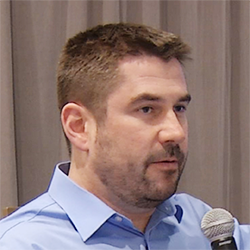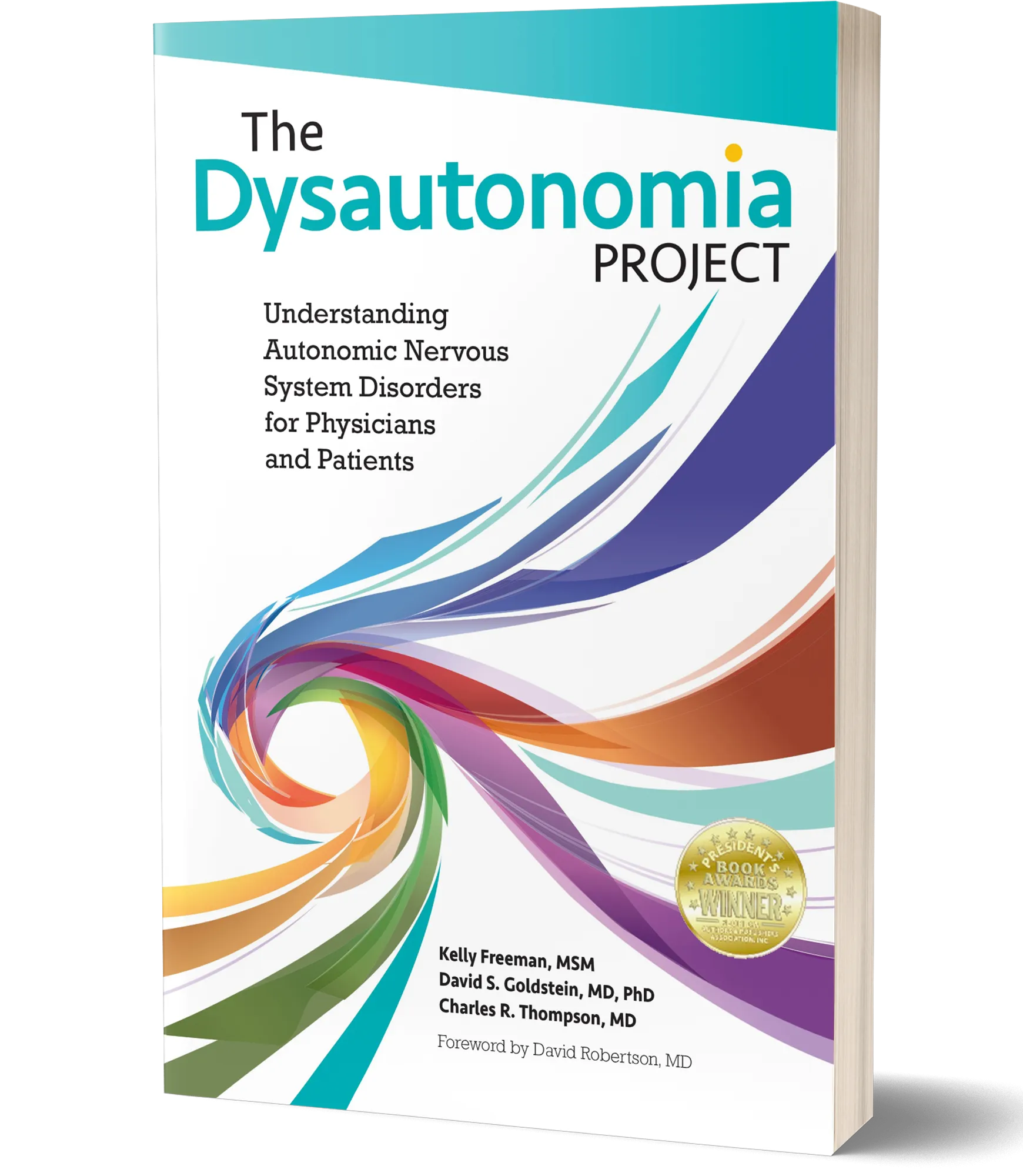POTS: Orthostatic Intolerance, Tilt Table Test & Hydration with Paola Sandroni, MD, PhD
Video Transcript
Mr. Al Ruechel: Hello everyone, I’m Al Ruechel thank you for joining us. In this segment we’re going to be talking about POTS and specifically how important is the “O-T” in the phrase POTS and then how important is the “S”, it will all make sense I promise in just a minute. Doctor Paola Sandroni joins us right now from the Mayo clinic, I grew up in the Iowa, Minnesota border so I know all about the Mayo clinic. Tell me about your background and how you’re involved with POTS in particular.
Dr. Paola Sandroni: I started working in the autonomic field thirty-years ago and this was the time when really we started to realize what POTS was and we’ve been working on that since and obviously I’m interested in any other disorder of the autonomic nervous system as probably you already know and I’ve been on staff at Mayo for over twenty years.
Mr. Ruechel: Ok, for those who don’t know what does POTS stand for?
Dr. Sandroni: POTS stands for postural orthostatic tachycardia syndrome however, this was the original name we give it and then we realize that probably orthostatic was redundant so the “O” became not in capital letter, it became P little o and the T and the S remain caps. Having thought about that a little further probably the O should still be in caps letter because postural for us in the autonomic field we already understand the means of the patient has to be in a standing or changing from a more recumbent to sitting position and then standing but literally speaking postural could go the other way around so sometimes I may have patient that tells me they get dizzy when they lay down so that’s a completely different situation. So, I think the O is still important.
Mr. Ruechel: Right, so this is interesting about POTS and all of the dysautonomias they get very very complicated because you look at them one way and you expect this outcome but then you look at another person and it’s just the opposite outcome. So, in a clinical setting how does that work trying to determine what is affecting that patient?
Dr. Sandroni: Well, if it’s for orthostatic intolerance we really need the orthostatic component so the patient standing. Or could even be in very serious conditions going from supine to siting some patients can feel light-headed and have blood pressure that drops. But, for other patients, when the situation is the opposite, then we are dealing with a completely different disorders that have nothing to do with the autonomic nervous system necessarily.
Mr. Ruechel: Medicine is often a process of elimination isn’t it?
Dr. Sandroni: Correct.
Mr. Ruechel: And that process can become very very complicated. So, tell me a little bit more about the clues that you would get from a clinical evaluation that would tell you in what direction you need to move.
Dr. Sandroni: Well, when the patient tells me whenever I stand or if I do things too quickly or even if I start exercising to intensely I start to become light headed, I feel faint, and my heart races that’s a good clue that we are dealing with a disorder of reduced orthostatic tolerance by definition. But I needed to make sure that there aren’t other factors going on, that the patient has a vertiginous syndrome or there is some other medical condition. So, that’s really where the patient, tedious work of elimination starts.
Mr. Ruechel: And what tests do you actually give them to find this out. Is this the tilt table we’ve talked about?
Dr. Sandroni: The tilt table is the easiest.
Mr. Ruechel: Tell me more about that.
Dr. Sandroni: So essentially, we strap the patient to a table that can be tilted. You can do a poor man version in your office having the patient lay down for a little bit, measure the pressure laying down, and then have the patient stand, but it’s not quite the same because if you stand in an active fashion, you have more muscle action and so that test is less sensitive. While if the patient is strapped and doesn’t do any movement but we tilt the table that becomes more sensitive and then we see that the pressure shouldn’t drop in postural tachycardia syndrome but the heart rate response is excessive and inappropriate that’s the key component. If I have a patient with orthostatic hypotension and they compensate tachycardia, that’s an appropriate response, in patients with POTS there is no need for that excessive heart rate.
Mr. Ruechel: Now does everyone react the same to that test so that you know it’s a reliable test per say?
Dr. Sandroni: Should be yes. Obviously if I have a patient that took medication or if the patient is particularly dehydrated that will make the test less specific but that’s what we try to eliminate and we try to standardize it as much as possible.
Mr. Ruechel: So, dehydration why does that play a role in it?
Dr. Sandroni: It’s crucial because if I have a patient that’s dehydrated, I will see the blood pressure compresses a little bit so when they stand their systolic blood pressure will drop a little while their diastolic blood pressure will rise some and the patient will have a little bit of excessive tachycardia. It may not necessarily be in a pathologic range but that can definitely be detected.
Mr. Ruechel: Now, talk to be about the role of salt. Water, dehydration, and becoming hydrated I kind of understand. What role does salt play in all of this?
Dr. Sandroni: Salt is fundamental to allow the blood volume to expand. If I only put water in my system, chances are within half hour it is out of my system, the same way it came in. So, in order to expand my blood volume, I need also salt that will retain the water.
Mr. Ruechel: It’s interesting because for people that aren’t dealing with these kinds of diseases, when you say you need more salt in your diet your brain kind of goes wait a minute I thought we were supposed to cut down on our salts but in this case. So, how this the salt delivered then into the body. Is it done intravenously, is it done through tablets, how?
Dr. Sandroni: Well, if you like salty foods that is the best way to get it, actually,
Mr. Ruechel: Really?
Dr. Sandroni: I mean there are a lot of foods that contain a lot of salt and so some patients love it and some patients don’t have a taste for salt. So, in that case the salt tablets are the easiest way to get it. Intravenous is a very difficult discussion because it’s valuable only if the patient let’s say has a intercurrent illness or whatever and they cannot have an adequate oral intake. Intravenous is good for an acute event but it’s valued only for an hour or so and then after that again the kidney will have taken care of it so there is no point in giving IV periodically unless again there is an acute medical illness that will require that.
Mr. Ruechel: Now, how much do doctors really know about renal salt and handling and those kinds of things because that’s kind of one of those issues that would be very specific to what you’re doing but also to dealing with people that deal with dysautonomias in general.
Dr. Sandroni: I think it’s pretty well known. Obviously, most people know that salt is bad as you were just saying because everyone know yes it raises your blood pressure. But that’s what we want in patients with dysautonomia, at least a little bit. So, but has to be done in a proper manner, because if you have too much salt that causes a whole other set of problems, if you don’t have enough salt well the blood pressure is going to be low, your blood volume is going to be small. Water, water is good, too much water, just free water that’s not good either.
Mr. Ruechel: So, because you’ve been working in this field for so long have you seen changes in the way it’s being treated? I mean physically treated in terms of trying to do rehab or whatever need to be done.
Dr. Sandroni: I would say that more and more we are using less medication these days and more non-pharmacological strategies. So yes, the fluid, the salt and the exercise are our holy trinity literally and you cannot just do one you have to do all three.
Mr. Ruechel: Right and that takes discipline doesn’t it. So, just a couple more questions in terms of, the doctors that are watching this or healthcare professionals give a one liner about what they should about this interview we’re doing right now. What’s the most important thing they should know?
Dr. Sandroni: Keep in mind that the patient may present with a lot of different symptoms again, this is not a disorder, this is not a disease, it’s a syndrome and that’s what we use to say this is the POTS package so they may have gastrointestinal symptoms, brain fog, fatigue, every patient will describe a little different particularly if you have a young woman and traditionally we are talking thin people. They seem to be more susceptible to low blood mass. If they are hypermobile, if they have lightheadedness, if they feel not up to par, check for this.
Mr. Ruechel: Right and that was the S that we had talked about when we started our program right here. Lastly, for patients that are watching this right now because it’s on a website, we’re hoping that as an educational tool there will be a lot of people watching this. What would you tell them, the patients?
Dr. Sandroni: Keep it up with the fluid, and oral fluid and not IV. It’s a big deal to have a central line, lots of risk of trouble, infection, blood clot, it doesn’t provide any advantage. Unless you are really hooked up daily and you keep infusing continuously which is impossible. Drink plenty of fluids, get your salt, get your exercise, be patient but we’ll get there.
Mr. Ruechel: Be patient, we’ll get there, that’s a great message. Doctor thank you so much for your time, we appreciate it and good luck as you do your continued research up at Mayo.
Dr. Sandroni: Thank you and thank you for having me.
Visit our Education Center for Autonomic Disorders for additional video resources for patients and providers

Wolfgang Singer, MD
Associate Professor of Neurology
Mayo Clinic Rochester, MN































